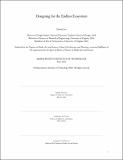Designing for the endless ecosystem
Author(s)
Lee, Nicolas(Nicholas A.)
Download1193024804-MIT.pdf (76.80Mb)
Other Contributors
Program in Media Arts and Sciences (Massachusetts Institute of Technology)
Advisor
Neri Oxman.
Terms of use
Metadata
Show full item recordAbstract
This thesis outlines a framework for sustainable design and fabrication bounded by the synthesis and decomposition of matter by ecosystems. In this methodology, matter is only temporarily diverted from the continuity of organic processes. Motivated by the immense power of ecosystems to efficiently produce and consume matter, this work proposes that both human and non-human systems can be made more efficient and powerful when industrial processes are embedded within ecosystems. This proposition is supported through case studies of three prototypical structures composed partially or entirely of organic matter. In each of these case studies, the framework is applied as a general strategy whereby computational tools simultaneously tailor the properties of abundant biopolymers and geometric designs to minimize discrepancies between the digital representation and physical manifestation of a fabricated object. Methods from a variety of disciplines are applied including energy analysis, mapping material flows, digital design, and additive manufacturing. The effect of this workflow is that abundant materials generally considered to be ill suited for fabrication are augmented with properties that allow them to meet design constraints. Efficacy is analyzed through the consideration of their impact at various scales of deployment, mapping of the material flows required to sustain such processes, quantification of each structure's energy and exergy, and the performative characteristics of designed objects as related to structural properties and biocompatibility. Through these cases and their analyses, this framework is broadly applied as a strategy for sustainable design with the ability to empower ecosystem resource cycles rather than deplete them. The impact of this framework is not limited to manufacturing and fabrication technologies but extends to materials engineering, biology, and ecology.
Description
Thesis: S.M., Massachusetts Institute of Technology, School of Architecture and Planning, Program in Media Arts and Sciences, May, 2020 Cataloged from the official PDF of thesis. Includes bibliographical references.
Date issued
2020Department
Program in Media Arts and Sciences (Massachusetts Institute of Technology)Publisher
Massachusetts Institute of Technology
Keywords
Program in Media Arts and Sciences